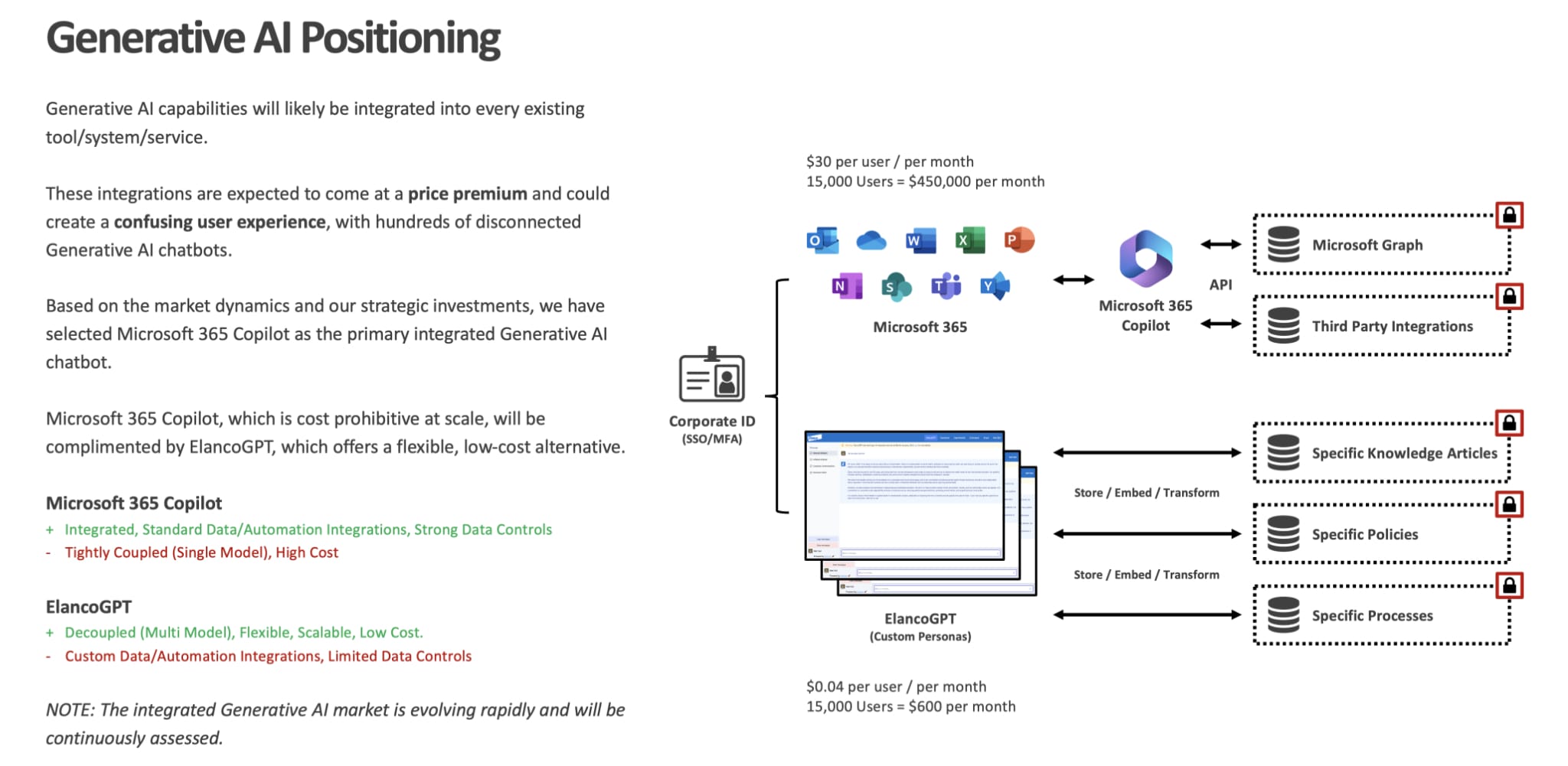Integrated Generative AI
Following the launch of ChatGPT in November 2022, Generative AI has captured the imagination of many around the world, including the mainstream media.
This “hype” has energised the technology industry, with almost every technology company releasing press materials that attempt to highlight their relevance, expertise and leadership in this new era of innovation led by Generative AI.
For example, Salesforce.com, ServiceNow, Workday, SAP, Veeva, Monday.com, and many others.
Suspiciously, before November 2022, not one of these companies even mentioned Generative AI as a feature or area of interest/investment.
In the context of enterprise business, there are two notable exceptions, specifically Microsoft and Google.
Microsoft, thanks to its deep partnership with OpenAI, has launched Bing AI and a series of Copilot products, with the flagship being Microsoft 365 Copilot, which integrates with Word, PowerPoint, Excel, Outlook, Teams, etc.
Google has its in-house developed Generative AI models, accessed via Bard and Duet AI, which is the equivalent to Microsoft 365 Copilot, integrated with Google Workspace.
Microsoft 365 Copilot and Google Duet AI are both premium add-ons (not included as part of existing licensing), conincidently, both with a list price of $30 per user, per month.
It is unclear how much these services cost to operate, but at this price point, integrated Generative AI features are a serious investment for any enterprise business. For example, enabling Microsoft 365 Copilot or Google Duet AI across an enterprise business with 15,000 users would cost an additional $450,000 per month ($5.4M per year).
If we assume other technology companies (e.g., Salesforce.com, ServiceNow, Workday, SAP) also plan to monetize their Generative AI features, the combined cost could be astronomical, destroying any return on investment, ultimately making it unaffordable for even the richest companies on earth.
As an alternative, in May, my team launched a custom-developed Generative AI Chatbot for business, designed to accelerate productivity by streamlining common tasks.
I have documented the development process in the following articles.
- OpenAI ChatGPT
- AI - Rise of the Machines
- Generative AI for Business
- Prompt Engineering
- Generative AI for Business - Update
- Generative AI - Embeddings
- Generative AI - Context
Our custom-developed Generative AI Chatbot can be compared to ChatGPT, capable of understanding and generating human-like responses to text-based inputs, with specific business features and controls to ensure security, privacy, legal, and compliance.
It should be noted that it is not embedded or tightly integrated into a specific suite of applications or services (like Microsoft 365 Copilot and Google Duet AI).
In my opinion, this is both an advantage and disadvantage, as the decoupled architecture allows for multiple models (e.g., GPT-3.5, GPT-4, PaLM2, Llama 2) to be used, with data being easily ingested from multiple sources (no proprietary integrations and/or specific vendor lock-in).
However, some of the advanced features such as automated actions within applications or services (e.g., Word, PowerPoint, Excel) will be more difficult (maybe impossible) to achieve.
As of September, our Generative AI Chatbot for business has scaled to ~3000 unique users, with the architecture costing a total of $120 per month to operate. If we assume a linear cost increase, which would be the worst-case scenario, 15,000 users would cost just $600 per month ($7,200 per year).
That is just $0.04 per user, per month, resulting in a total yearly saving of $5,392,800 when compared to the list price of an integrated Generative AI service such as Microsoft 365 Copilot or Google Duet AI.
At this early stage, it is impossible to know if an integrated Generative AI service offers enough unique value over a custom-developed Generative AI Chatbot, to cover the additional $5M per year price point. What is clear, having multiple integrated Generative AI services is not feasible (at least today, at the current market pricing).
Therefore, we have chosen to proceed with a strategy that selects one integrated Generative AI service targeting specific users (those where the value is clear), supported by a low-cost, but highly flexible custom-developed Generative AI Chatbot for everyone else.
The document below highlights this positioning, including the differences between an integrated Generative AI service and a custom-developed Generative AI Chatbot.
As noted in the document, our selection for an integrated Generative AI service is Microsoft 365 Copilot, as we are a large Microsoft partner, consuming their core productivity, collaboration, data and information security capabilities.
As previously stated, Microsoft is also a leader in this space with the ability to influence the market dynamics, opening the door to third-party integrations, etc. For example, an ability to access data across the Microsoft Graph or via plugins.
We believe this strategy offers the best of both worlds, securely embracing and enabling Generative AI across the business to unlock new insights and productivity acceleration, whilst managing cost, ensuring the implementation is righ-sized as we scale.
